Retired U.S. Air Force F-15C Eagle pilot Colonel Cesar “Rico” Rodriguez has an incredible story to tell. In his 26-year service career, he played important roles in two major air wars. Remarkably, it’s almost 30 years since “Rico,” who still goes by his Air Force callsign, first sat in the cockpit of his McDonnell Douglas F-15 Eagle ready to go to war on a sweltering night in Tabuk, Saudi Arabia. Operation Desert Storm was the first chapter in his incredible story. “Rico” and his fellow Eagle “drivers” etched one of the most fearsome reputations in combat aviation as an invincible band of lethal airborne enemy aircraft slayers. Of the 32 air-to-air kills by Eagles of that war, two were his.
He was part of the 58th Tactical Fighter Squadron (TFS), and strapped to his jet were four live AIM-7M Sparrow radar-guided air-to-air missiles and four shorter-range AIM-9M Sidewinders. Eight years later he would fly another fully armed F-15 into combat, this time with new weapons and upgraded systems, in the skies over Kosovo as part of Operation Allied Force. Here he would notch up his third kill.
Today, he recounts his extraordinary experiences in the cockpit of the Eagle to help new recruits understand the importance of training and striving for excellence. It was what prepared him when he went into combat at very short notice. Rodriguez and his fellow Eagle pilots knew instinctively what to do, a fact that he emphasized in his exclusive interview with The War Zone.
The path to the Eagle cockpit
Speaking from his office in Tucson, Arizona, “Rico” tells us how he always dreamed of flying F-15 Eagles, but that he was still honored to initially be awarded a place on a Basic Course learning how to fly the A-10 Thunderbolt II. “I got to fly some very complex and demanding missions as an A-10 pilot in Korea for two years. I had almost 900 hours of “Hog” flying in that time — which is pretty amazing.”
When he subsequently went back to Holloman Air Force Base in New Mexico as an instructor for lead-in fighter training, he did so with an eye on the prize of an F-15 cockpit. “I started to add more air-to-air backseat rides in the T-38 during CT [Continuation Training] with former F-15 pilots and we could fly against F-15s from the squadron across the street at Holloman. It really helped me to build my three-dimensional situational awareness picture of the air-to-air mission using my eyes and ears. It helped me immensely when I eventually got selected to go to Tyndall [Air Force Base, Florida] to start a short F-15 transition course.”
“The F-15C is a very complex weapons system. I was able to employ the training I’d already established, but now as a young F-15 pilot,” he continued. “When you start to apply the intricacies of HOTAS [Hands-On Throttle And Stick] controls and the physical demands of flying a jet without a G limiter, plus adding the visual feed of the radar and the audio lead of the radar warning receiver, then you can start understanding how to max-perform the Eagle.”
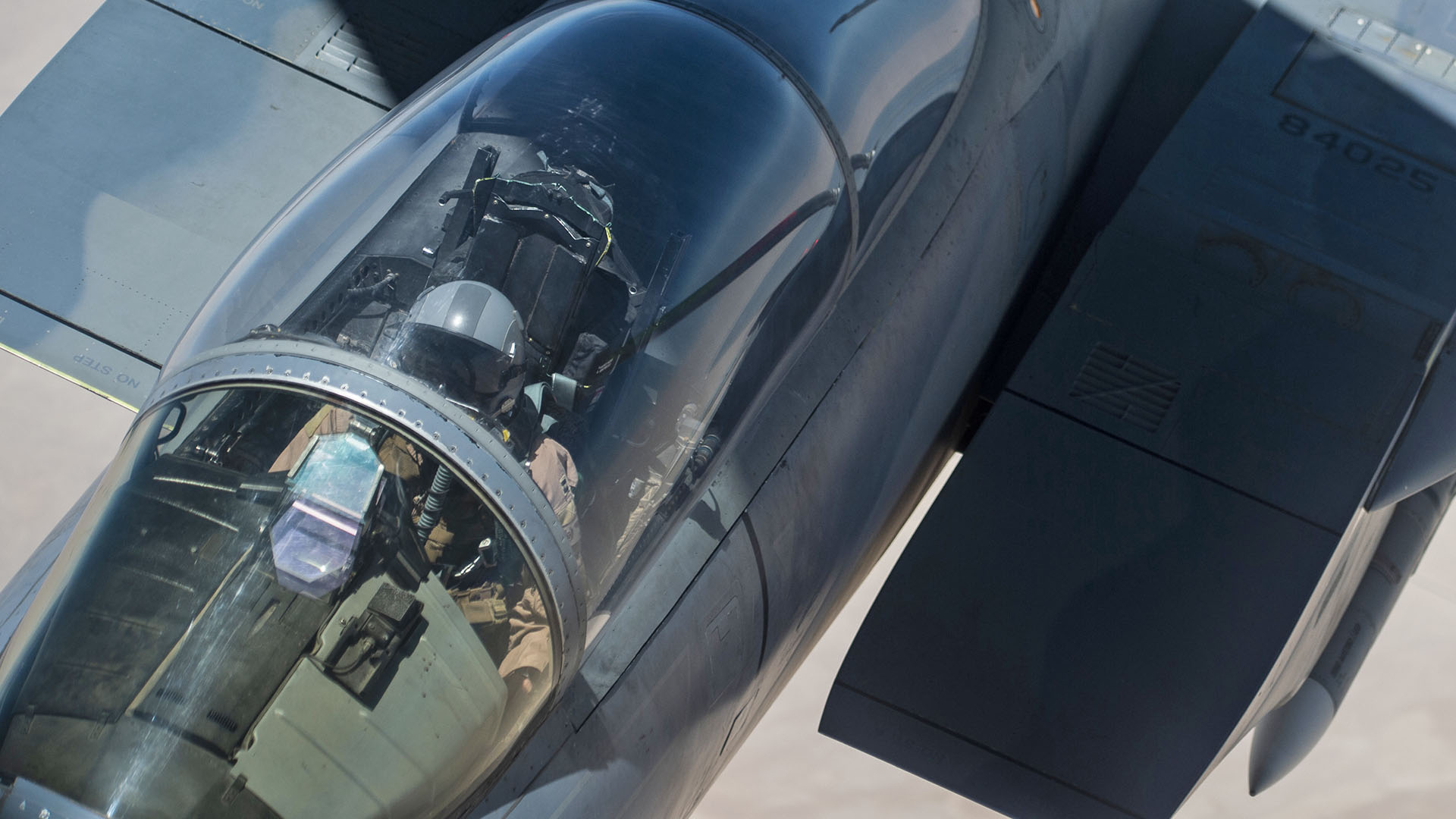
“Rico” completed Eagle school and joined the 58th TFS, the “Gorillas,” at Eglin Air Force Base, Florida, in 1989. He then began working through his Mission Qualification Training. This is the process junior pilots must work through on an operational unit to progress from being a wingman, through two-ship lead, four-ship lead, and ultimately become a mission commander.
“Little by little I started to feel more comfortable in the jet,” he says. When “Rico” arrived at the 58th TFS, the squadron commander Lieutenant Colonel Francis “Paco” Geisler had assembled an impressive team that was stacked with weapons officers and a huge amount of collective experience. “We had a very strong squadron, both in terms of hours and capability. It included Captains John ‘JB’ Kelk, Rick ‘Kluso’ Tollini, and Robert ‘Cheese’ Graeter. The mindset was that we were going to be the baddest guys in the air — it was never a cakewalk.”
In the summer of 1990, Rodriguez led a detachment to Gulfport, Mississippi, in support of some Missouri Air National Guard F-4E Phantom IIs that were on their squadron’s “fini” deployment before transitioning to the Eagle. “We had eight jets and a full maintenance contingent there for a week. It was the final day and we did an 8-v-16 air-to-air mission — it was their take on World War Three! We did everything to give them a chance to see what the F-15 could do and that last day was full-up beyond visual range — all the handcuffs were off!”
“When we landed we had planned one heck of a party, but the crew chiefs came over to my jet and said they’d received word from Eglin that we weren’t to party. As a matter of fact, we had to pack our bags and get back home that evening.”
“They put the tanks back on the jets and we left for Eglin, taking off into the approaching sunset.”
“We all flew straight-in approaches, and as I rolled down the runway I looked right and could see huge activity all over our flight line — I’d never seen it so alive in my life. It was wall-to-wall F-15s armed with live [AIM-7] Sparrows and AIM-9M [Sidewinders].”
“Once we got to the squadron building we were told that we’d been put on deployment orders. The CO said: “We don’t have a date yet, but go home and put yourselves into crew rest.”
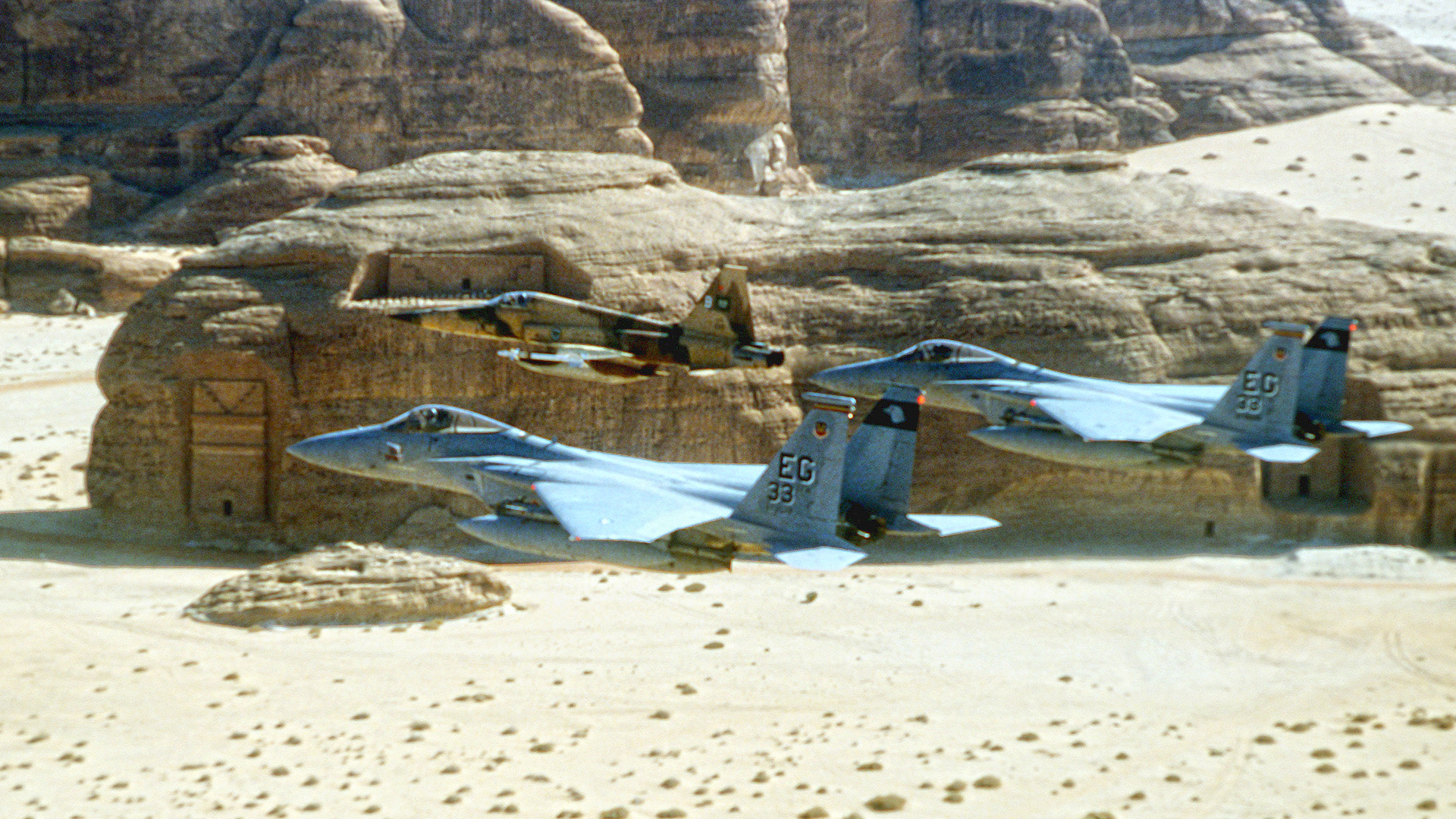
On Aug. 2, 1990, Saddam Hussein’s Iraq invaded Kuwait. U.S. President George H. W. Bush ordered ground, sea, and air forces to Southwest Asia to stabilize the region and persuade Saddam to withdraw his invasion force. For “Rico” and the rest of the 58th TFS, it was a tense time. “We sat tight and did a lot of mission study plus briefings relative to the Iraqi air order of battle and GBAD [Ground-Based Air Defenses]. We were tweaking our tactics based on the threat intel we had.”
“Paco” Geisler had turned the “Gorillas” over to Lieutenant Colonel William “Tonic” Thiel — but not before he’d assembled a team that was fully prepared and ready to go to war.
Heading to Saudi Arabia
Thiel was notified shortly after the Iraqi invasion of Kuwait that his squadron was tasked to deploy and he was ready to send 769 personnel and 24 F-15C Eagles. “Rico” picks up the story:
“They informed us there would be two Eagle squadrons deploying; us and F-15s from Langley [Air Force Base, Virginia]. When we planned the deployment a big hurricane was building in the Atlantic Ocean, which meant the northern route around Greenland and the United Kingdom was out for us. So they built a huge tanker bridge literally right around the Equator so we could go the long way to Saudi Arabia. There were several spots on that bridge where if we couldn’t take gas from the tanker, the only option was to bail-out near a boat in the Atlantic.”
A lot of that Atlantic crossing involved flying in bad weather. As we hit the eastern Atlantic we refueled over the Strait of Gibraltar, staring straight at the rising sun. Our last tanker bracket was over Egypt and from there we headed into Saudi Arabia.
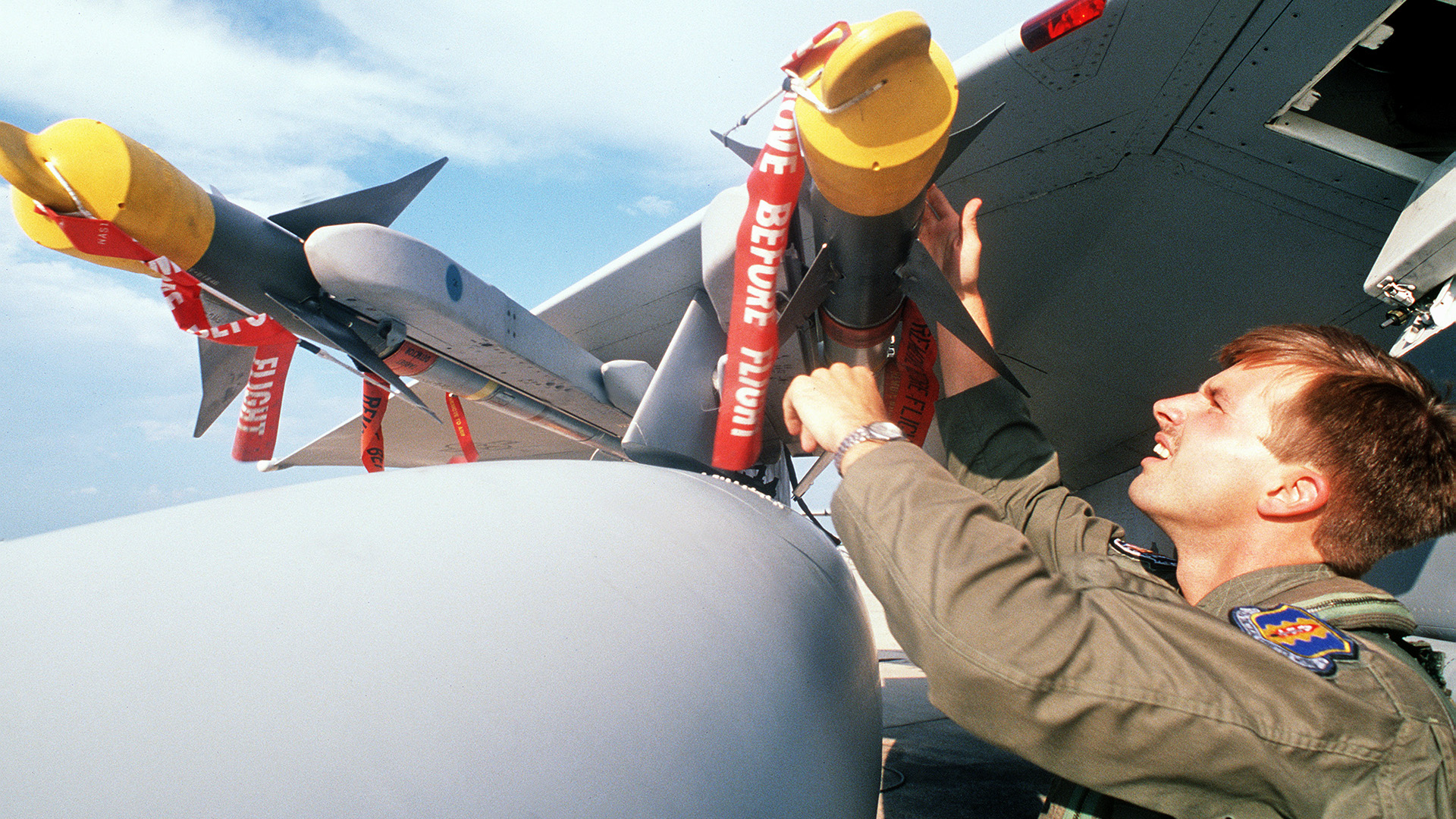
It was late August, and really hot when we landed. From the time I strapped into the jet at Eglin until I got out in Tabuk it was about 22 hours — it was one of those days that never ended, people had to be literally craned out of the cockpits.
We put birds on alert within 48 hours of arriving and were manning alert CAPs [Combat Air Patrols] and undertaking a couple of ATOs [Air Tasking Orders]. Initially, it wasn’t 24/7 CAPs; we flew when some kind of high-value asset was in the air. It took a little while before we set up round-the-clock ops around the AOR [Area Of Responsibility]. We saw the Iraqis launch [MiG-25] Foxbats and they were our main concern in the Desert Shield phase ahead of the main Operation Desert Storm. They executed their launch profiles really nicely. If we didn’t exercise “Grinder” tactics properly we wouldn’t be at the right altitude to take a shot at them — we might need to turn before the Iraqi border.
“Grinder” involved us having one group of F-15s “hot” [radar pointing at the target] and one group “cold” [flying away from the target]. We had to grind ourselves back far enough, with enough distance, so that when it looked there was a true commit from them across the border, we could jettison our tanks and climb into the high 50s [nearly 60,000 feet] and have a high enough Mach number to launch our AIM-7s. It took time for us to talk to the E-3 AWACS to help us get to the right shoot box should the opportunity present itself.
Flying as two-ships and four-ships presented one of the true lessons of Desert Storm — pairing up your teams. It was a myth that we had more than enough pilots, we didn’t, but we needed experience in the teams. By pairing us up in combat it gave us the flexibility to fly whatever schedule was given to us. Once the war kicked off, all the wingmen were at least two-ship flight lead, so they could become number three if required.
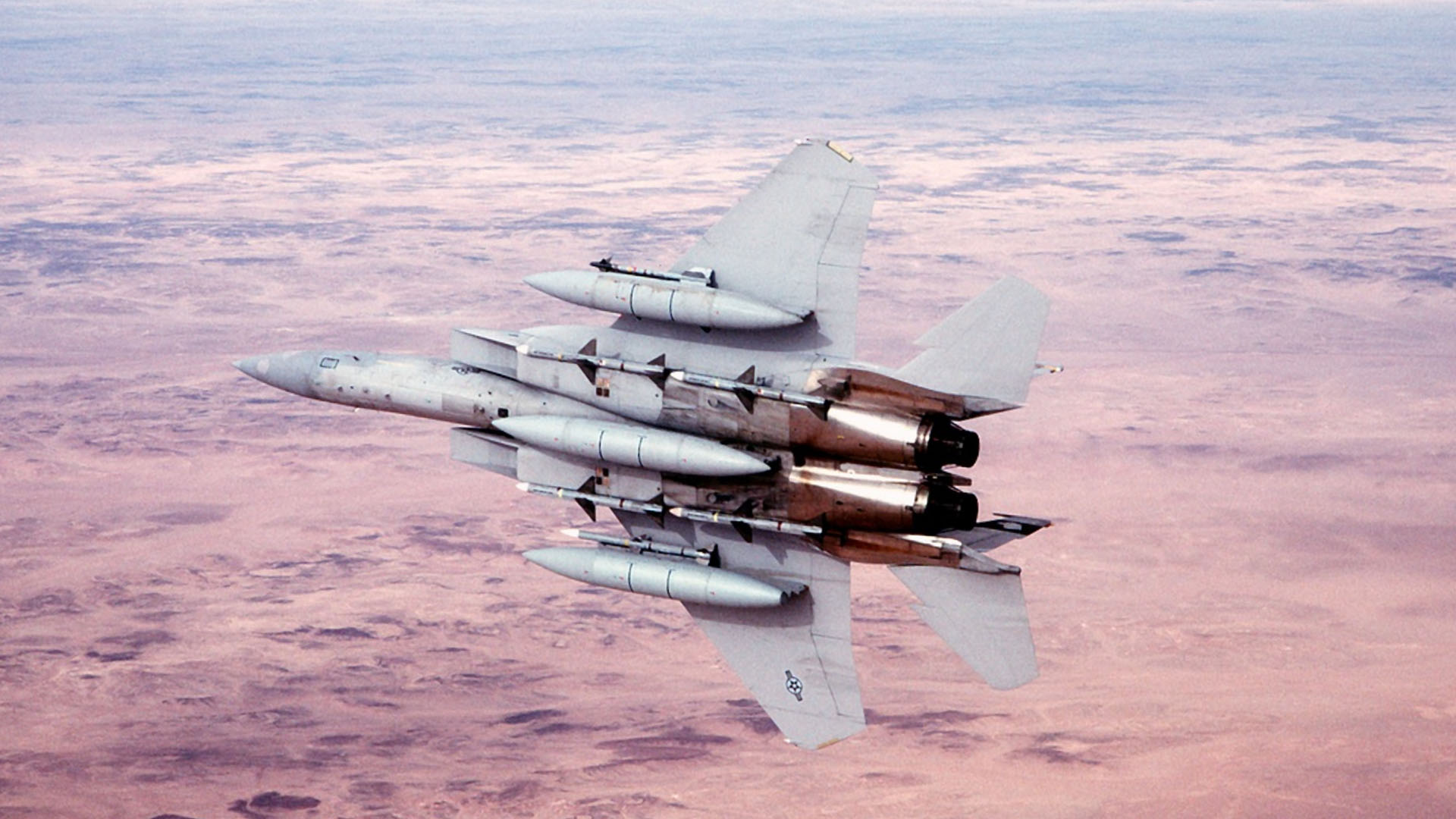
Only on one occasion did we break up our pairs. The four-ship meant we could fly any mission — Offensive Counter Air [OCA] and Defensive Counter Air [DCA] and if we were on the ground, one could act as the SOF [Supervisor Of Flying], one could sit “Top Three” — on the ops desk — and the other two could help with the mission planning cell.”
Eagles into the storm
At midnight on Jan. 17, 1991, the assembled Eagles both at Tabuk, and the jets from Langley at Dhahran, Saudi Arabia, joined forces on the first night of Operation Desert Storm with a surprise attack over Baghdad. Their mission was to clear the skies of Iraqi fighters over the capital and open a “lane” for the strike force.
The first wave of missions saw Captain “JB” Kelk from the “Gorillas” claim the first aerial “kill” of the war for the Eglin Eagles, downing a MiG-29 Fulcrum with an AIM-7 Sparrow. That same night, Captain Rhory “Hoser” Draeger and U.S. Marine Corps exchange officer Captain Charles “Sly” Magill took out a pair of MiG-29s near Baghdad before Captain “Cheese” Graeter then claimed two Dassault Mirage F1s.
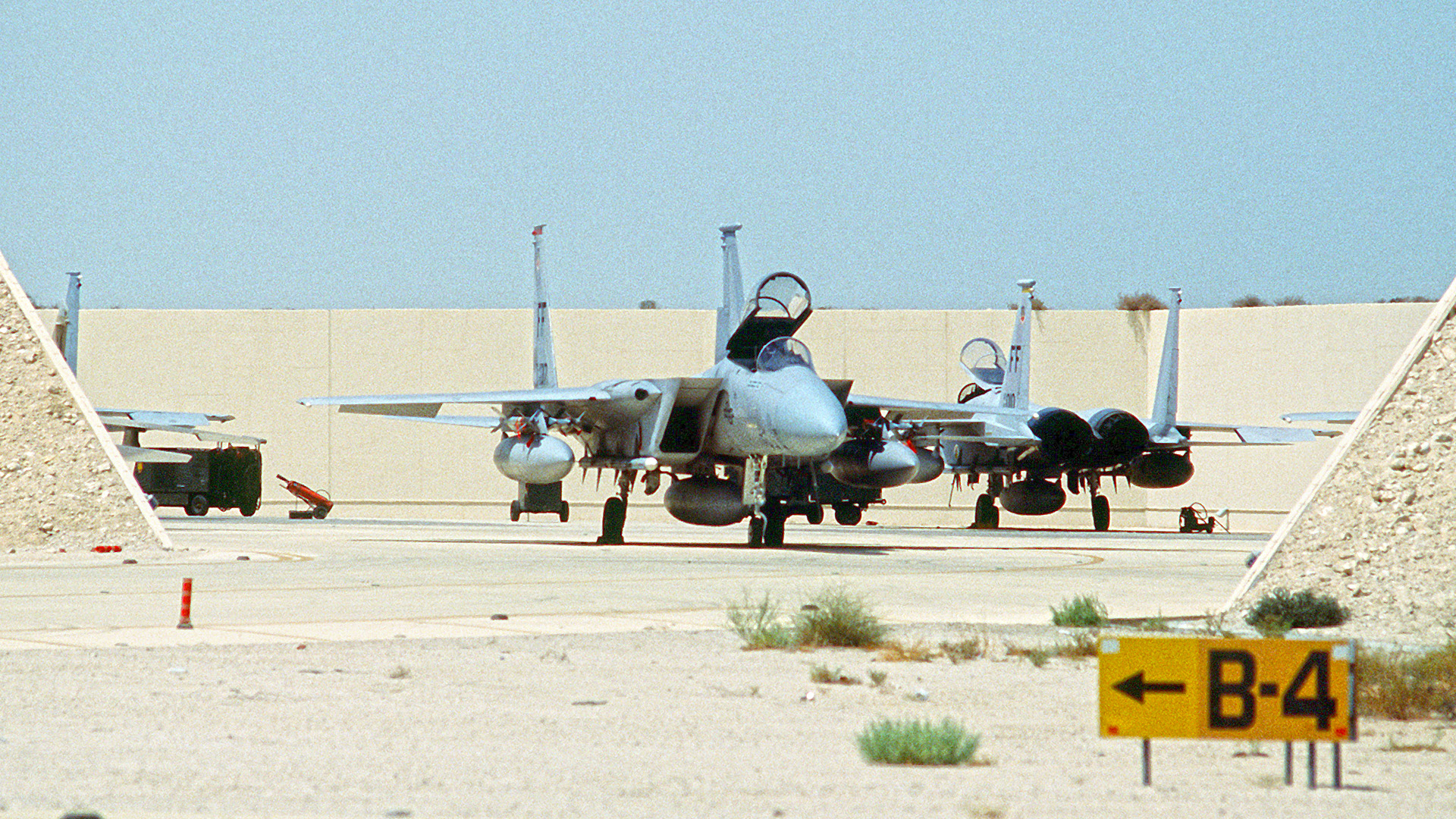
“Rico” takes up the story:
“I flew the very last mission of Desert Shield before we moved into Desert Storm. We got a couple of hours of sleep and came in to fly a couple of DCA missions on day one. On Jan. 19, again I was on DCA in the western sector [flying F-15C 85-0114], protecting the high-value assets in what was known as HVACAP, but then me and my wingman Captain Craig “Mole” Underhill were switched to OCA. A strike package was supposed to be supported by the Langleys, but they had to weather-cancel. So they scrambled F-15s from Tabuk to be the OCA four-ship, led by Rick Tollini. The mission commander said to leave a two-ship DCA in the CAP and take two DCA birds forward to become the post-strike OCA for the strike package. “Mole” and I went to the tanker, got on the frequency with Rick, and his four-ship for the final briefing from the mission commander — it was a push.
We were on the tanker still pressing north when Tollini and his flight engaged a variety of threats. They ended up getting two “kills” in the early stage of the push. They ended up jettisoning their external fuel tanks, which meant they no longer had enough gas to get to the target area and then come home. So, the mission commander committed the group forward with “Mole” and I at the tail-end to climb up and start building a radar picture in front of the strike package — taking the role of lead OCA.
As we built that radar picture we had one unknown contact extremely far in the north and west. Then eventually we developed a second contact northeast and east, which was the closest to us and originated out of the Baghdad area. As we were proceeding forward on track we handed over the western contacts to our AWACS controller to monitor, we were going to put our radars into the eastern group. As we started to commit on that group, elements of our strike package were starting to hit their targets. The eastern group came at us in what we call a Res [resolution] Cell, meaning we couldn’t break them out at the long-range with our radar.
Eventually, we could see it was a two-ship, slightly echelon formation, to the north-northwest, and as we got close they went from close to a tactical formation. Then, low and behold they executed the tactic that all of our Red Flag exercise debriefs had told us about. There were known blind zones in our mechanically-scanned radar and these guys went into the notch at exactly the right range, so we lost our locks on them for a while. As they started to “drag” [give the impression they were leaving the engagement], we picked them up again. We were now inside the Sparrow WEZ [Weapon Engagement Zone], but if we were going to take a shot we were going to have to follow them for a long time [to support guidance of the missile]. The MiGs went into a “beam” maneuver [perpendicular to our track] and held it for what felt like 15 secs, then turned and “dragged” again. They weren’t in afterburner, and we were coming out of high altitude, so we could have easily run them down. Meanwhile, the last striker called “Millertime,” meaning he was going to drop, so OCA was technically no longer required.
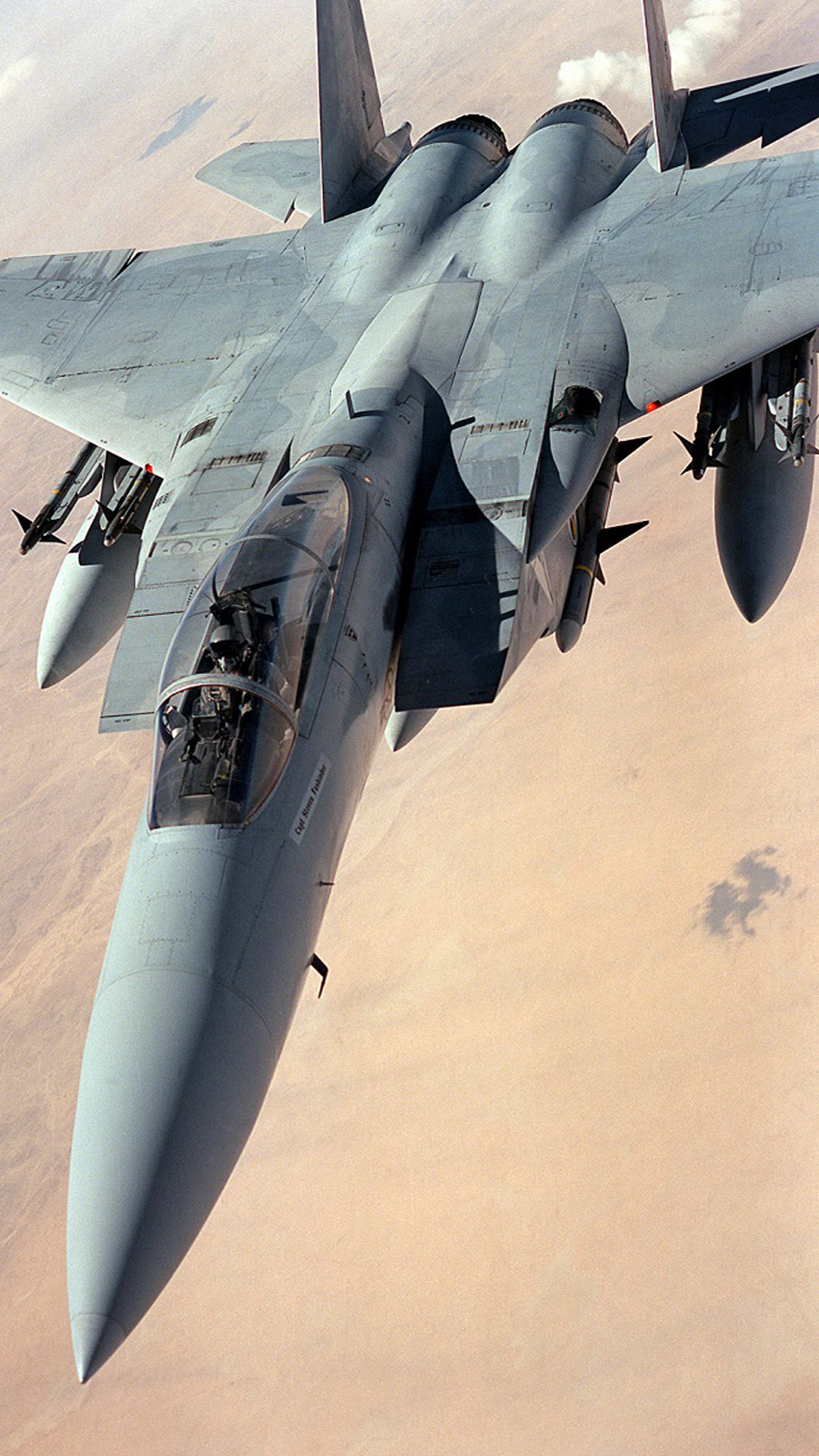
Just as I was about to call for “Mole” and I to abort, we got a radio call from the AWACS who said: “Citgo, pop-up contacts 330 for 8.” That was the bearing and range off of my jet, which put them in the 9-9:30 clock position for me. It was outside my radar field-of-view so I snapped to heading 330 — I don’t remember reaching down and jettisoning my fuel tanks, but I did.
As I turned my jet was immediately enveloped in vapor around the wings. “Mole” saw this and my fuel tanks flying off, and he initially thought that I’d been hit. I rolled out on 330 with my auto guns system on and boom, I got a lock right at eight miles. Very quickly I started to do an identification “matrix” on the threat [to find out what it was]. However, I immediately knew that this was not going to be valid because we had rules of engagement that required anything inside of 10 miles to be visually identified. The rules were written like this due to our ability with the radar in certain scenarios to “see” the F-117 Nighthawk. In hindsight, the way you write that is: when you are operating with an F-117, or at night in conjunction with an F-117, if you have a lock inside of 10 miles you have to identify it. It was re-written the next day.
Even when the fighter gave me a hostile lock it still wasn’t sufficient grounds to take a shot based on the ROE. I started thinking defensively, talking to “Mole” to get him to do his “matrix.” He was outside of 10 miles and could, therefore, meet the full intent, plus he had augmentation from an RC-135 Rivet Joint electronic warfare aircraft, which helped him out. I came out of 30,000 feet, rolled the airplane inverted and pointed my nose at the ground, dispensing chaff to decoy the threat away me, and my main aim was to get below his radar field of view and into the ground clutter.
As I passed through 5,000 feet I became concerned about hitting the ground, so I leveled off under 1,000 feet. I could see his lock on my RWR. [I found out later that between the Rivet Joint and my electronic warfare that his radar was being jammed appropriately and as a result he couldn’t employ any of his weapons against me]. When “Mole” finished up and got confirmation of the target being hostile, he took a shot.
I looked over my left shoulder and saw his Sparrow come off the jet and pull towards my high six o’clock. It stopped burning and I was straining to see the target. The smoke trail from his missile was a bit like a pointer. I took the trailing edge and followed it, and there I found the MiG-29, about three miles off my right wing. “Mole’s” missile hit him smack in his face and it turned the aircraft into what looked like a huge sparkler in the sky under the high noon sun. I called “splash one,” and as I did the AWACS came back: “second group north 10.”
We had a couple of options. The AWACS was notoriously about three miles off in their range estimations. So it could have been 13 miles or seven miles. We could have turned south and never seen the contact, but we decided to turn north. “Mole” was up in the high 20s and I was down very low. We would force the fighter to commit to one of us. As it turned out he didn’t lock either of us and on seeing him it allowed me to do a vertical lead turn on him from low to high to visually confirm him as hostile.
There were times it looked like an F-15, times it looked like an F/A-18, and it wasn’t until I passed about 50 feet off of his left wing that I was able to confirm it was a brown and green MiG-29 with the Iraqi flag on the fins. I started to gain some angles on him and the dogfight ensued. First merge I had angles on him. The next time at the 180-degree point of the circle I’d gained 90 degrees of angles on him, but I didn’t have a clear shot.
The engagement started at 8,000 feet and it was coming downhill fast. By the time I got my closure rate under control on the outside of the circle I was then coming back to the inside to get a sweet shot. He was at about 400 feet and I was 600-700 feet above the desert. I pulled to the inside of the circle to put my ASE [Aeronautic Steering Engagement] on him. That’s the aiming section for the AIM-7. There’s a dot in the HUD [Head-Up Display] and if you put the dot inside the ASE, you had a valid shot. I was still about 1,400 feet behind the MiG, but I wasn’t thinking about using the gun. He suddenly rolled inverted from 300 feet and started a Split-S maneuver, and of course, that wasn’t going to work for him. He hit the desert floor and ended up tumbling in a big fireball.
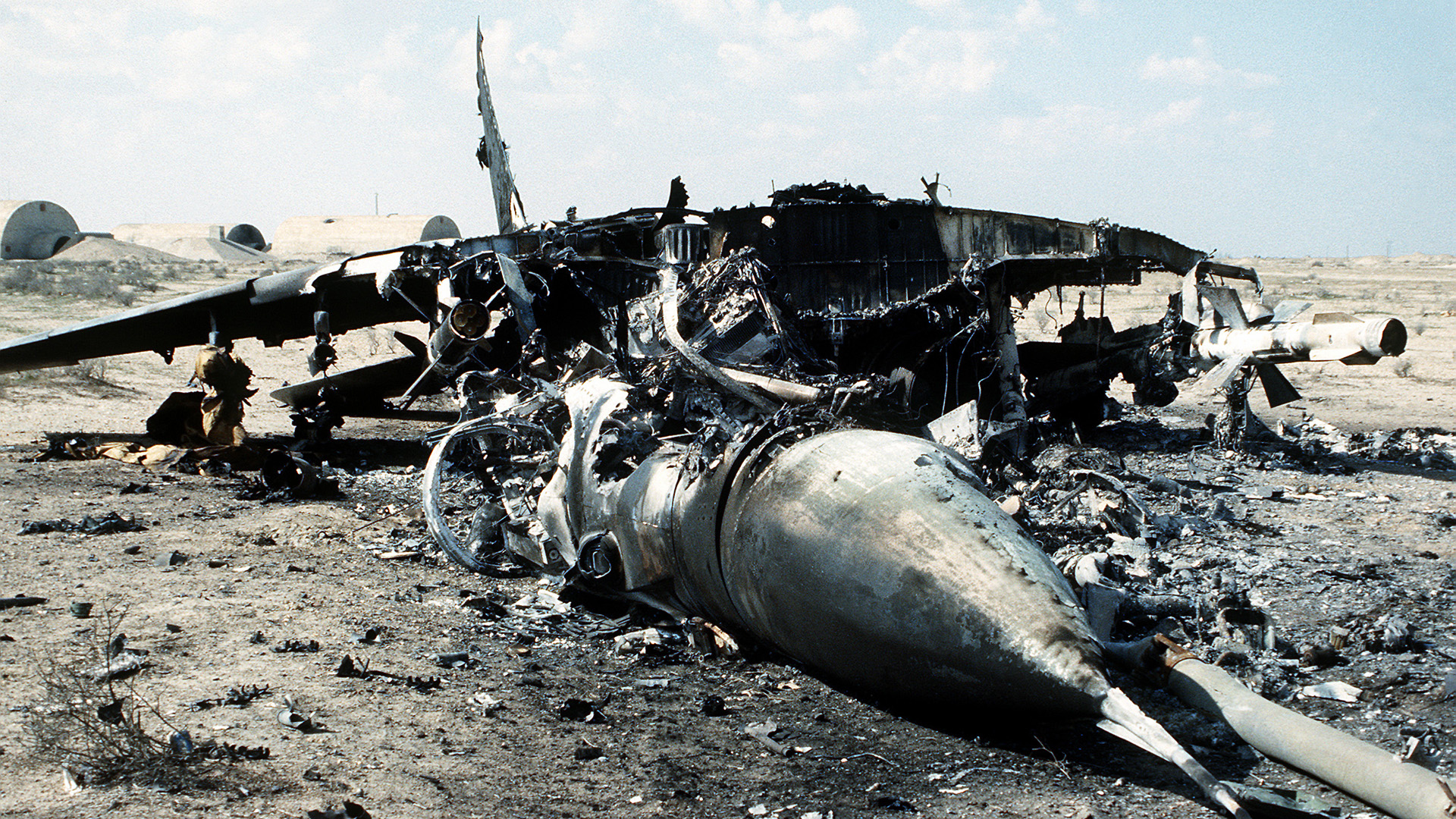
I got back together with “Mole” and we headed back to the tanker. Unbeknown to me, when my body reaches a level of adrenaline in a life and death situation I go into a severe series of tremors and shakes. So when we came out of this fight and got on the tanker to get some gas I thought it was time to start relaxing. I suddenly started to feel significant vibrations, and at first, I thought it was something wrong with the jet. I let go of the stick and grabbed the towel racks [hand grab rails on the canopy arch] and the jet leveled off and all was fine. It felt like forever, but was probably only a minute or so of serious convulsions going through my body. I didn’t think anything of it and certainly didn’t tell the flight doc!
As we were coming home I said to “Mole” that I thought it was the right time to do a low approach, kick in the burners and do an aileron roll. As it turned out, we got a pretty good ass-chewing from our wing commander for that hot-dogging. Back on the flight line I remember my crew chief wondering how I had managed to get a “kill” with all my missiles still on the jet!
We debriefed as a pair with the intel team and the mission planning cell for the report that went to CENTCOM [U.S. Central Command] and we were back flying the very next day. Celebration wasn’t really part of the calculation. We didn’t really see each other from the other four-ships. After “JB” and “Cheese” got their “kills” on night one, I don’t remember seeing them for almost a week. We used to say we operated on “leadership by sticky notes.” That’s how any congratulations were communicated — via a note stuck to our flight gear in life support.”
Second “kill”
Over the next few days, “Rico” and his associated four-ship flew a mixture of planned and alert scramble missions. He takes up the story:
“Typically we were flying two or three times a day. If you were on alert, you tried to get a little sleep. Generally, the flow was to get between four and six hours of sleep in between each working day. On Jan. 26, I was flying “114” again and that day it was really only the F-15Cs and the high-value assets like the AWACS that were up — the weather was terrible. That day was the first time I’d changed my wingman. Our formation was led by Captain Rhory Draeger, with Captain Tony “Kimo” Schiavi, myself as number three and my wingman was Captain Bruce “Roto” Till.
We were way up north of Baghdad when we got a radio call that there was activity in the area of H2 Air Base, which was way out to the west. Rhory re-formed us in the traditional “Wall-of-Eagles.” We were very high, and I thought we’d never see anything that we’d be able to shoot at, but our AN/APG-63 radar had no problem “seeing” through the weather, and we could fire AIM-7s through the clouds as well.
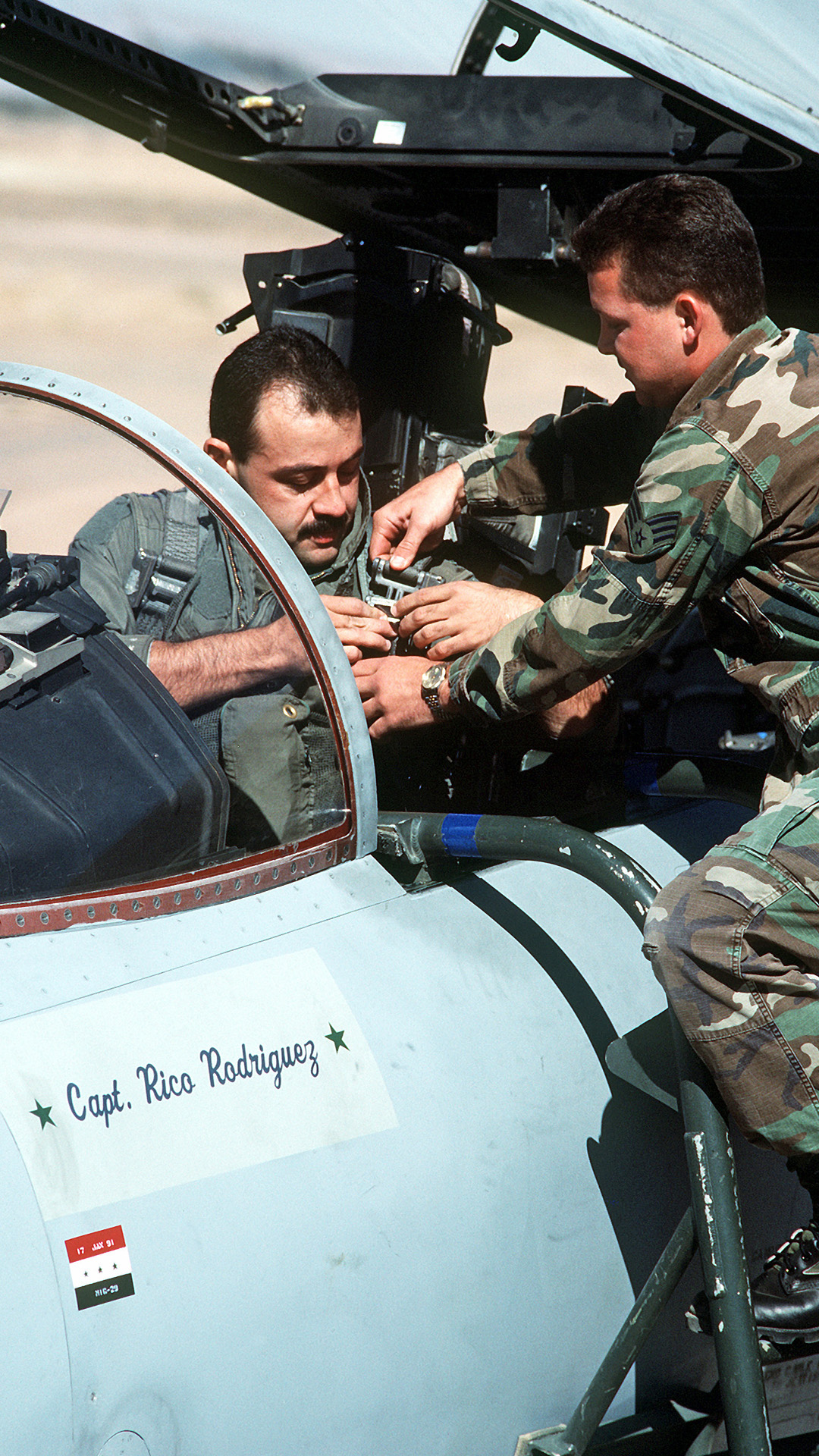
About 25 miles from where we’d calculated the merge would take place we saw a huge sucker hole in the clouds and could see the ground. We all dived through it and came out at around 15,000 feet. We continued to dive down to around 10,000 feet while tracking the Iraqi fighters that were flying a very low level at about 400 knots, navigating along a major highway in a Vic formation [one aircraft leading, with one on either side in echelon]. As soon as we came through the clouds I could see through my target detection (TD) box in the HUD a small dot that little by little built into the silhouette of a MiG-23 Flogger.
We “sorted” the target group in F-15 standard procedure, which means the flight lead takes the enemy leader, the number two takes the northern contact and I took the southern guy, while the number four pilot searched around us [for any other contacts]. We were completing our ID “matrix” when we received information from the AWACS that a U.K. Special Operations guy out in the desert had earlier visually confirmed three MiG-23s were moving on the flight line at H2. He’d passed the information to the E-3 crew with the proper authentication — so we had a human intelligence, as well as our own electronic identification. We also found out later, via the special ops guy, that one of the MiG pilots was a cousin of Saddam Hussein.
With the targets confirmed, Rhory took his shot and I saw the missile come off the rail and quickly accelerate down toward the desert floor. It leveled off at around 50 feet — the same altitude as the MiGs. “Kimo” fired his Sparrow and then I fired mine. The first missile appeared to pass the lead MiG, but soon it became apparent that it had flown close enough to do some kind of damage as the jet started turning and trailing smoke, before catching fire. Rhory pulled off to the north and uncaged a Sidewinder ready to hit him again, but as he did the MiG blew up.
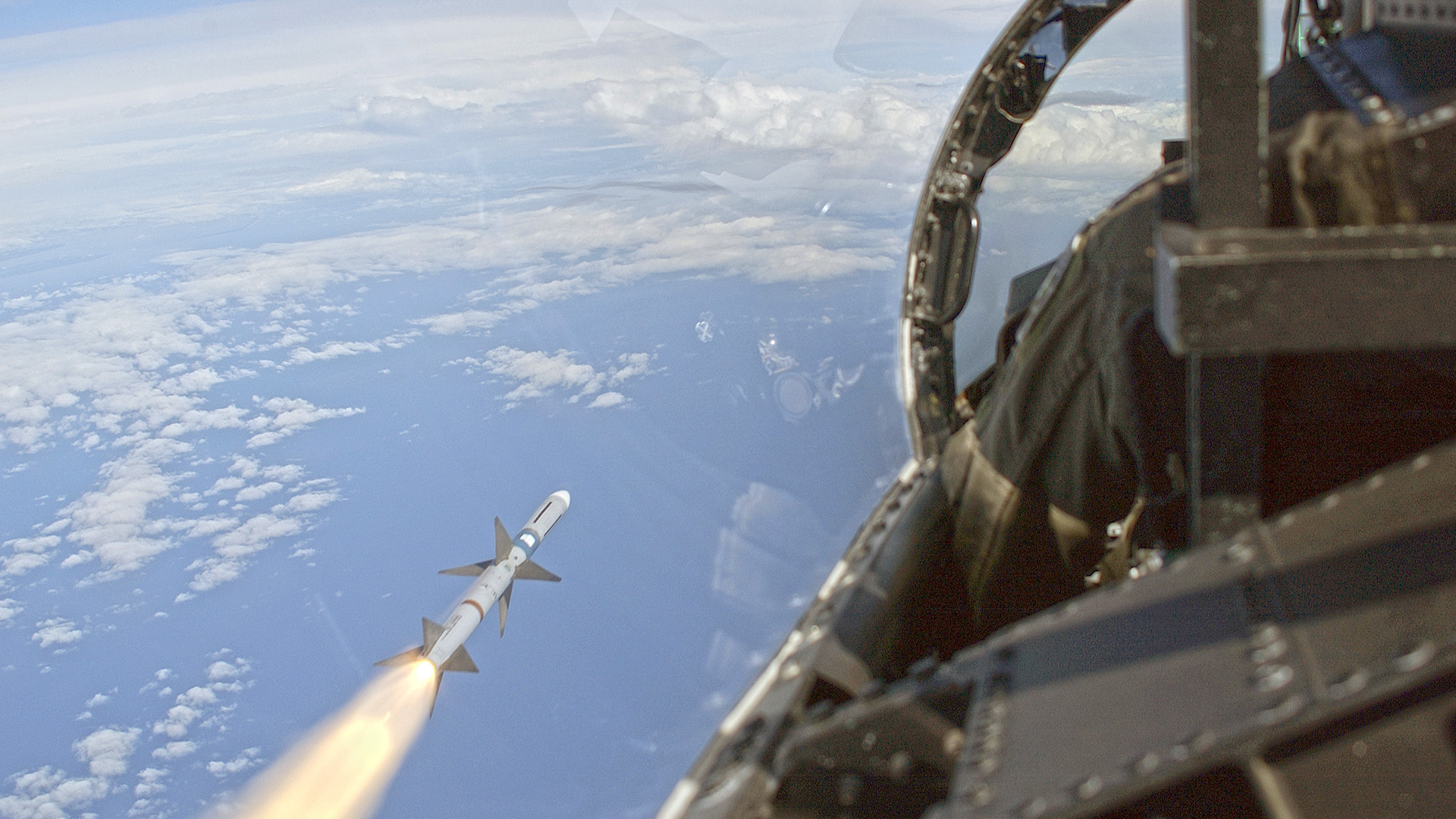
In the meantime, the two Iraqi wingmen checked south and in doing so heated up the intercept with our missiles. Nearly simultaneously both missiles hit their respective targets and both MiGs crashed either side of the highway in two huge fireballs.
I suspect the MiGs never knew we were there until the leader was hit. They had flown a comms-out launch and were using the road to navigate their way to Baghdad to get fuel before continuing onwards to Iran, where a lot of Iraq’s fighter aircraft had fled.
This intercept continues to be used in the training environment as what people call “the classic.” We used minimum communication, we had near-perfect radar synchronization in the four-ship for sorting and targeting the MiGs. People who have heard the [cockpit recorder] tapes always ask how Rhory and I remained so calm as we got ready to shoot missiles? I tell them that there’s a certain calmness there because we’d both been there before — for both Rhory and I these were our second kills.”
Rodriguez says that as the war progressed, the F-15C’s prowess led to more pilots becoming keen to put their training into practice and claim more aerial victories. It was what he called “MiG-itis.” Overall the 58th TFS claimed 16 aerial victories in Operation Desert Storm, more than any other unit. With 32 overall “kills,” the F-15C had proved its ability to surgically target and eliminate the enemy fighters with impunity.
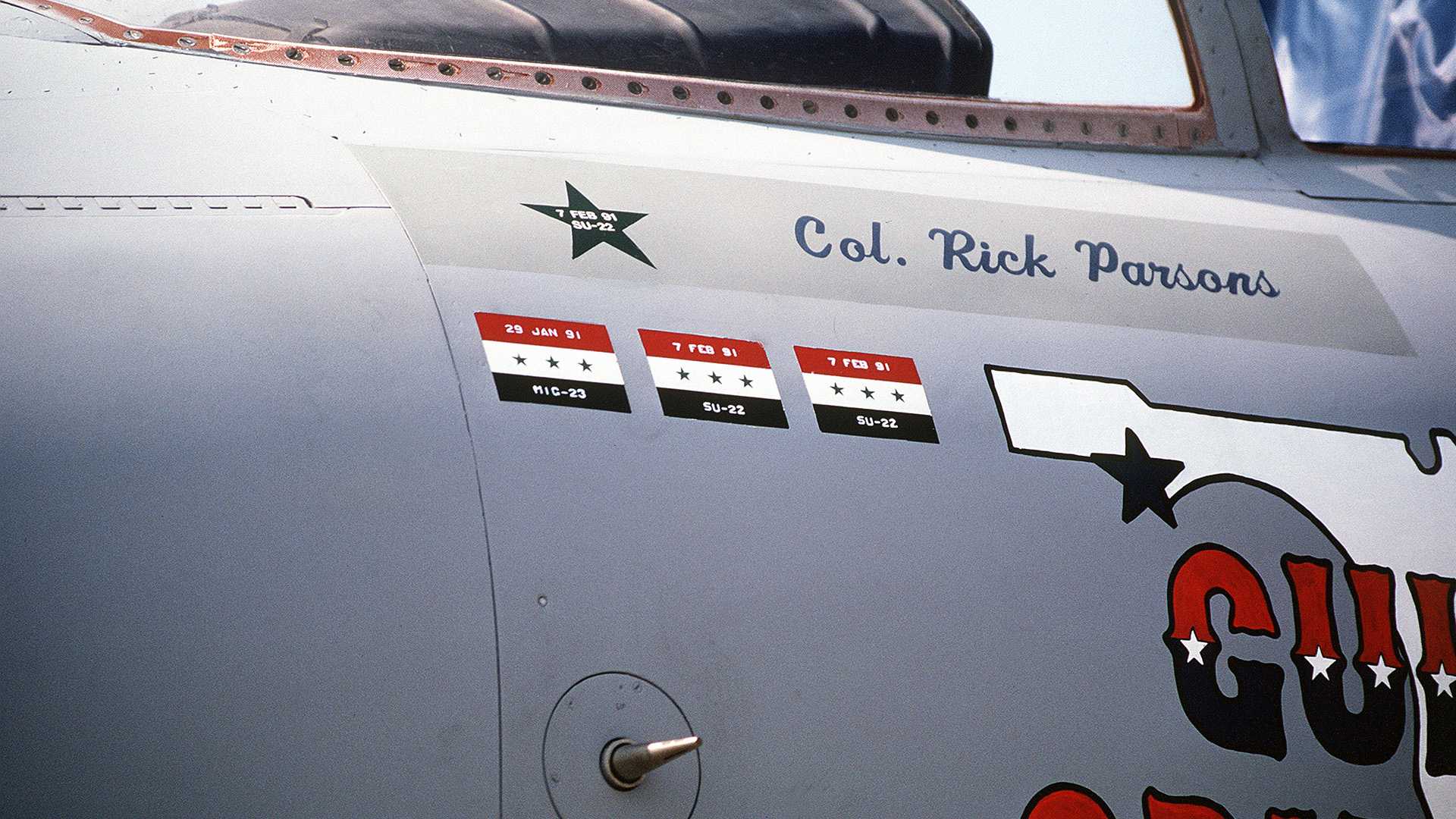
The third “kill” — Operation Allied Force
NATO launched Operation Allied Force in 1999 in response to Serbian President Slobodan Milosevic’s campaign of “ethnic cleansing” of Kosovar Albanians. Although NATO Secretary-General Javier Solana did not authorize airstrikes against Serbia until Jan. 30, the USAF had already worked up several potential air campaigns.
When it was finally decided, Allied Force was to be an operation designed to force Milosevic’s withdrawal from Kosovo. With the use of ground troops rejected by NATO, an air campaign was designed to focus on the Serbian air defense systems and otherwise employ strikes against Serbian military targets.
The first attacks of the campaign began on the night of Mar. 24, 1999, as aircraft from 13 member countries, including U.S. Air Force B-52s and B-2s, launched the initial phase of attacks under what the U.S. military called Operation Noble Anvil. “Rico” takes up the story.
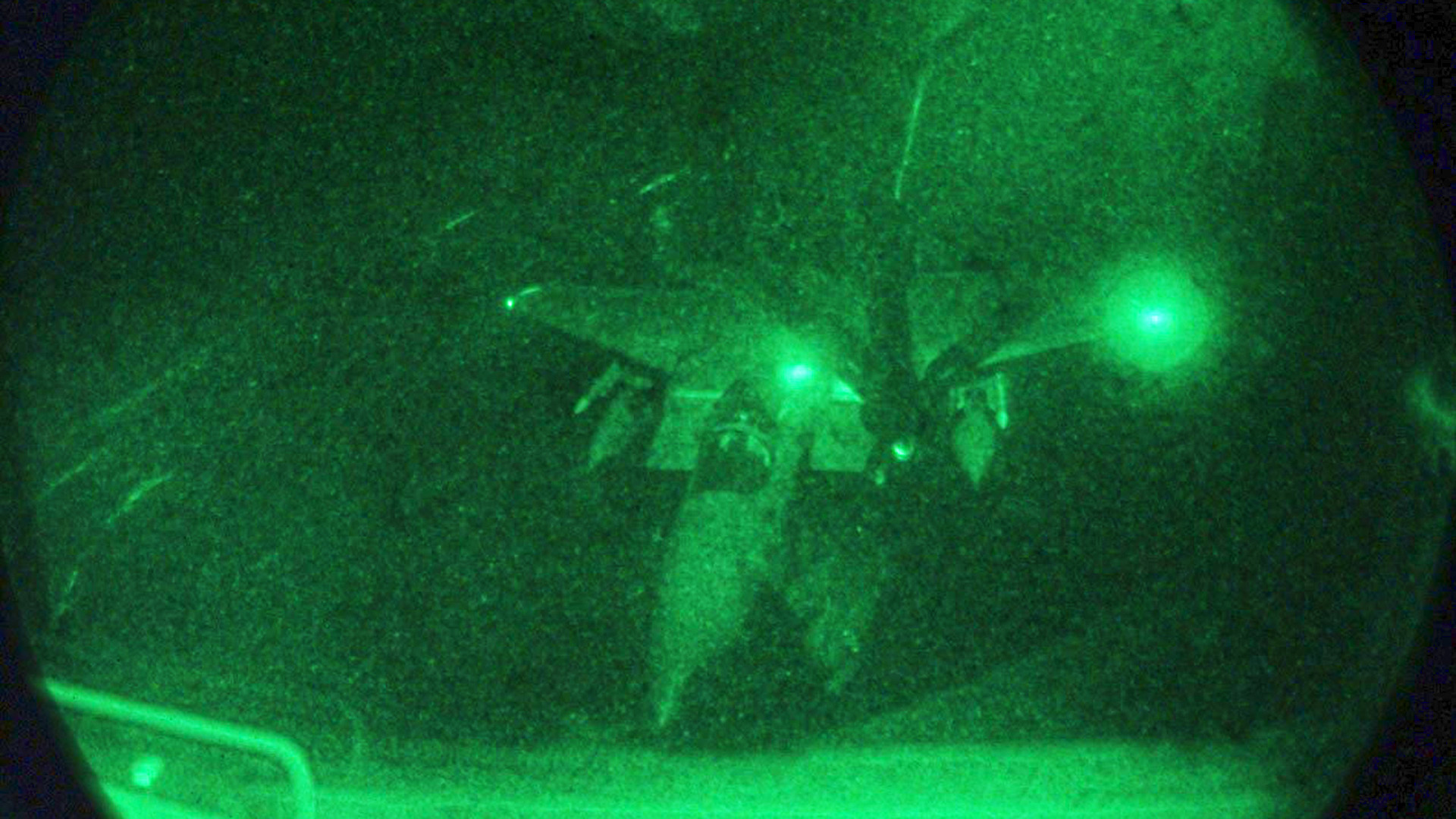
“I was by now a Lieutenant Colonel as the 48th Fighter Wing’s Chief of Safety, and flew F-15Cs with the resident 493rd Fighter Squadron, the “Grim Reapers.” We deployed as the only F-15C squadron to support the operation. We didn’t have the airplanes or the manpower to truly support all the ATOs [Air Tasking Orders] that were being contemplated for Allied Force, so it was literally a case of needing to get everyone downrange.
The wing commander deployed me as Chief of Safety and as a mission commander, and four-ship flight leader. We took jets from our home base at RAF Lakenheath, U.K. to Cervia Air Base, Italy, and we also had jets deployed to Turkey that we moved a couple of weeks before the war was projected to kick off to give us a complement of 22 Eagles.
In the latter stages of Desert Storm, the 58th TFS had been the first unit to receive the new AIM-120 Advanced Medium-Range Air-to-Air Missile [AMRAAM]. It had been on the drawing board and we’d trained some tactics before the war. Compared to the standard of the jets that we flew in Desert Storm, the F-15C had moved on significantly. Post-Desert Storm we had worked with industry and requested some upgrades. Now we all had AMRAAM, plus some changes to the cockpit because we found that we were flying some really long missions. That included things like improving the HOTAS to avoid having to reach around the cockpit too much, but we still didn’t have a data-link or Night Vision Goggles.
Once settled in Italy, we started flying Initially in the DCA role, but that eventually evolved into full-up combat operations. We generally had three main areas of operations. One in the north along the Hungarian border. One in the center abeam the capital Belgrade, and one to the south where all the atrocities were taking place and where most of the strikers were going. So there we were tasked to maintain open flight lanes for them.

Serbian air activity was sporadic, but it indicated to us that we were dealing with a far more mature threat than we had seen in Iraq, especially with the Integrated Air Defense Systems [IADS] they were employing. You might be on CAP in an area you thought didn’t have an IADS, then all of a sudden your RWR would light up like a Christmas tree and you’d have a different Surface-to-Air-Missile [SAM] indication in every quadrant!
For the opening night of the campaign, I was in F-15C 86-0169, which we called “The Love Machine.” As we got to our jets at Cervia, our intelligence officer came out to provide us with an updated Electronic Order of Battle. It included details of two MiG-29s that been seen in Belgrade, but were no longer there.
From a tactical perspective, it didn’t change our planning — we were prepared to fight a highly maneuverable target set with an all-aspect radar and infra-red-guided missile. But it was great situational awareness for us because the general thinking was that the Serbian MiG-29s were only interested in protecting the capital.
We launched across the Mediterranean and hooked a left turn up the Adriatic. The flight lead and his number two were on the western side, with me and my wingman to the east. Our plan was to get to our point of protection near Montenegro and set up an east-to-west corridor for the strikers to start going in. It also coincided that it in a straight line from our lane was the town of Pristina, where Slatina Air Base had underground storage for aircraft.
I was flying from south to north and I could see between the mountain peaks an occasional radar blip for a contact that was moving northbound, but I could never lock it up. The aircraft seemed to be hiding in the mountains while trying to build some situational awareness with his ground-controlled intercept operator so they could snap him onto a vector to go against the leading edge of the strike package we were protecting. Once he started to climb above the ridgeline at around 11,000 feet, he became a clear target.
I locked him up at about 50 miles from me. I tried to engage my AWACS controller, but he was a little perplexed and not quite as prepared as he should have been. He was asking more questions than he was providing answers. As I was monitoring and tracking it, it came to a point where it was no longer in our best interests to let this guy go unchallenged. I’d done everything an F-15 could do to positively identify the target, and I was 99.9% sure it was a MiG-29 and that it had come out of Slatina, but the current rules of engagement specified that the AWACS had a vote in the identification “matrix.” When it became clear he couldn’t get his vote to me in time, I took the shot.

The AMRAAM shot was beyond 35 miles, and about the time I took it, my wingman started to get locked-up by SAMs in the area, so I cleared him off to the west. The missile appeared to be guiding well and I didn’t feel I needed to take a second shot. As it was counting down in the HUD with five seconds until impact I got my eyes on the bearing and range of the threat and began to move away from the SAMs — by now some of the indications I had in my cockpit indicated full lock and I was sure they were getting really close to shooting some missiles at me.
Sure enough, the timer indicated zero and to the split second the fireball ensued at about 15 miles in my two o’clock position. It was a dark night and it was like they’d suddenly turned all the lights on in a row of stadiums at once, with the explosion reflected against the snow-covered mountains.
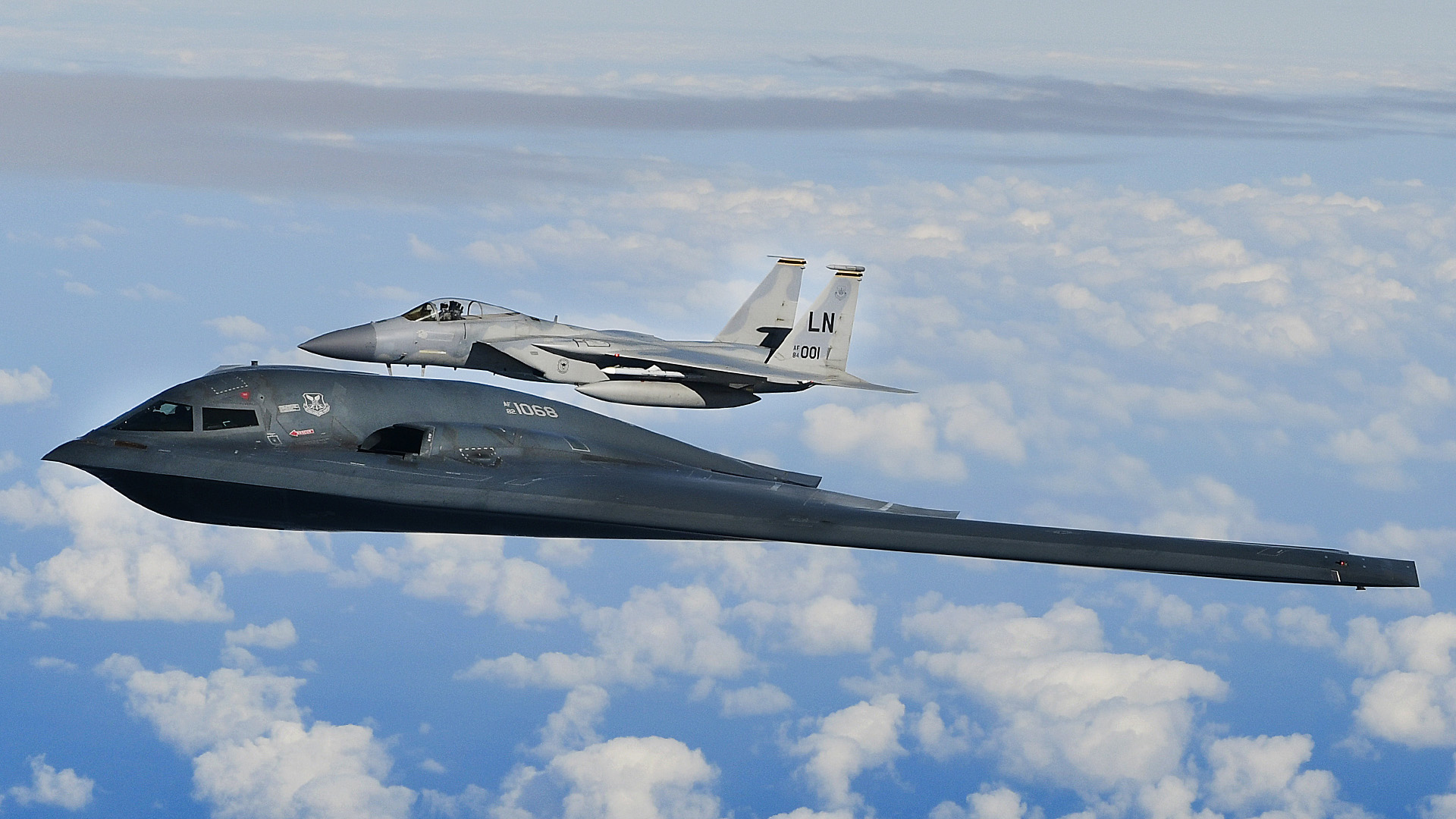
The MiG-29 “splash” occurred about seven minutes into our 50-minute VUL. We also had a follow-on 20-minute VUL to protect a flight of B-2s that were coming in from the south. Once all the strikers exiting the area, we were the last to leave.”
An enduring legacy
The 493rd FS notched up four “kills” during Allied Force, with Captain Mike Shower claiming a MiG-29 as it got airborne from Batajnica Air Base on the opening night, followed by Captain Jeff Hwang who claimed a double MiG-29 “kill” on Mar. 26.
Rodriguez subsequently moved to Headquarters, Air Combat Command, and was then promoted to full Colonel, moving to Mountain Home Air Force Base, Idaho, to become the deputy Operations Group Commander. He retired from the USAF in 2003 after 26 years, having accumulated some 1,700 flight hours in the F-15. He has worked for Raytheon since 2006 and is now the Vice President for Global Requirements and Capability in the Middle East for Raytheon Missiles and Defence.
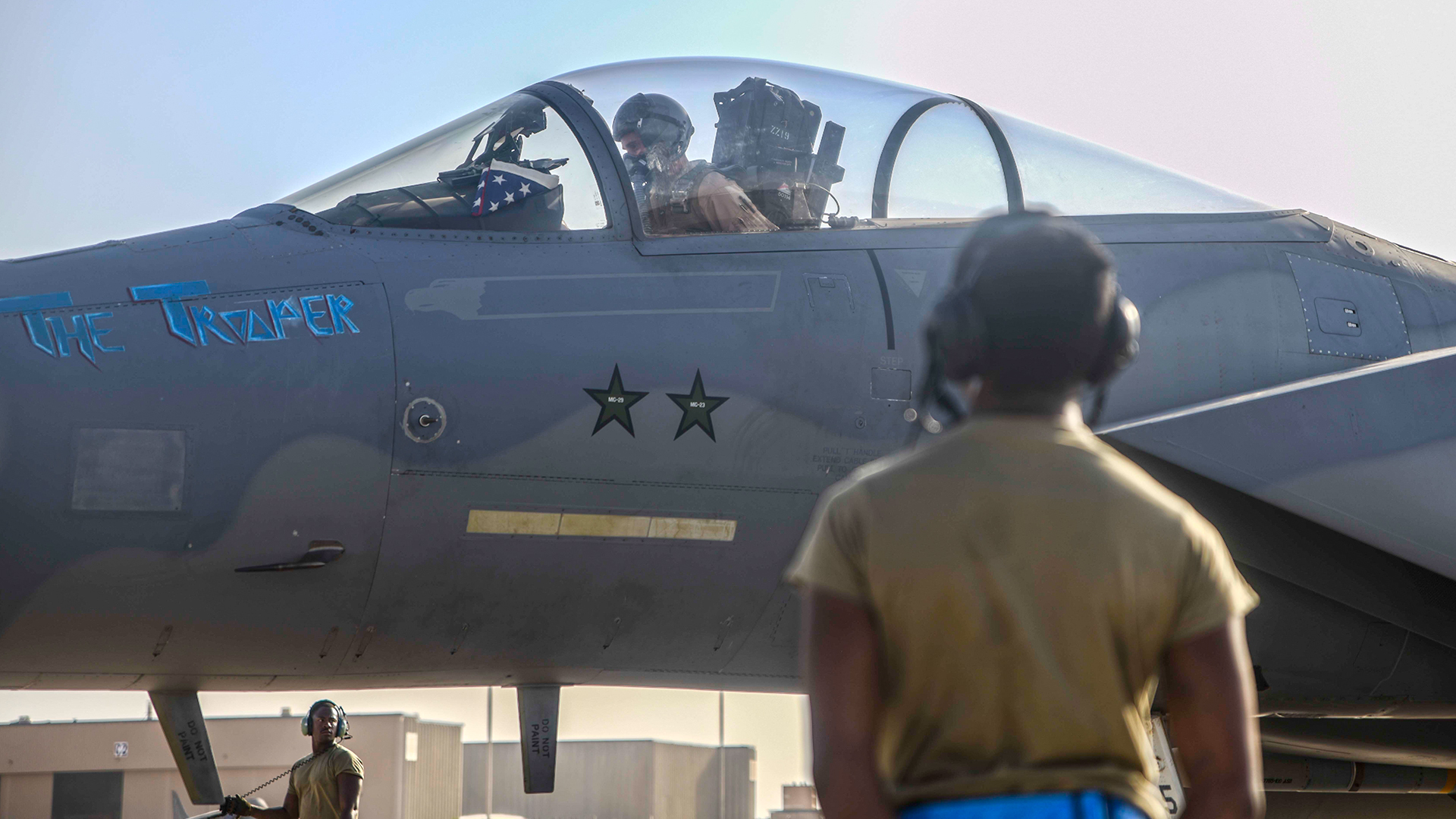
His incredible combat record makes him one of only three post-Vietnam triple “MiG-killers,” and the only one of these to have claimed them in two separate campaigns. He concludes:
“Being a fighter pilot is still the most dangerous profession in the world. When you’re in that zone as a young Captain with 300 hours under your belt, you truly feel like you are a part of that jet. Seeing ‘114’ still on operations, currently deployed to the Middle East as part of the 44th Fighter Squadron out of Kadena Air Base, Japan, she looks like the same bird on the outside, but internally she is very different.
F-15Cs today fly with a new Active Electronically Scanned Array [AESA] radar, a Fighter Data-Link, and the Sniper Advanced Targeting Pod to allow them to visually identify targets at long-range. Her maintenance team is taking great care of her.
Back then and to this day, the F-15C is what I call a ‘badass machine’ that can own the sky with the right training and maintenance supporting her.”
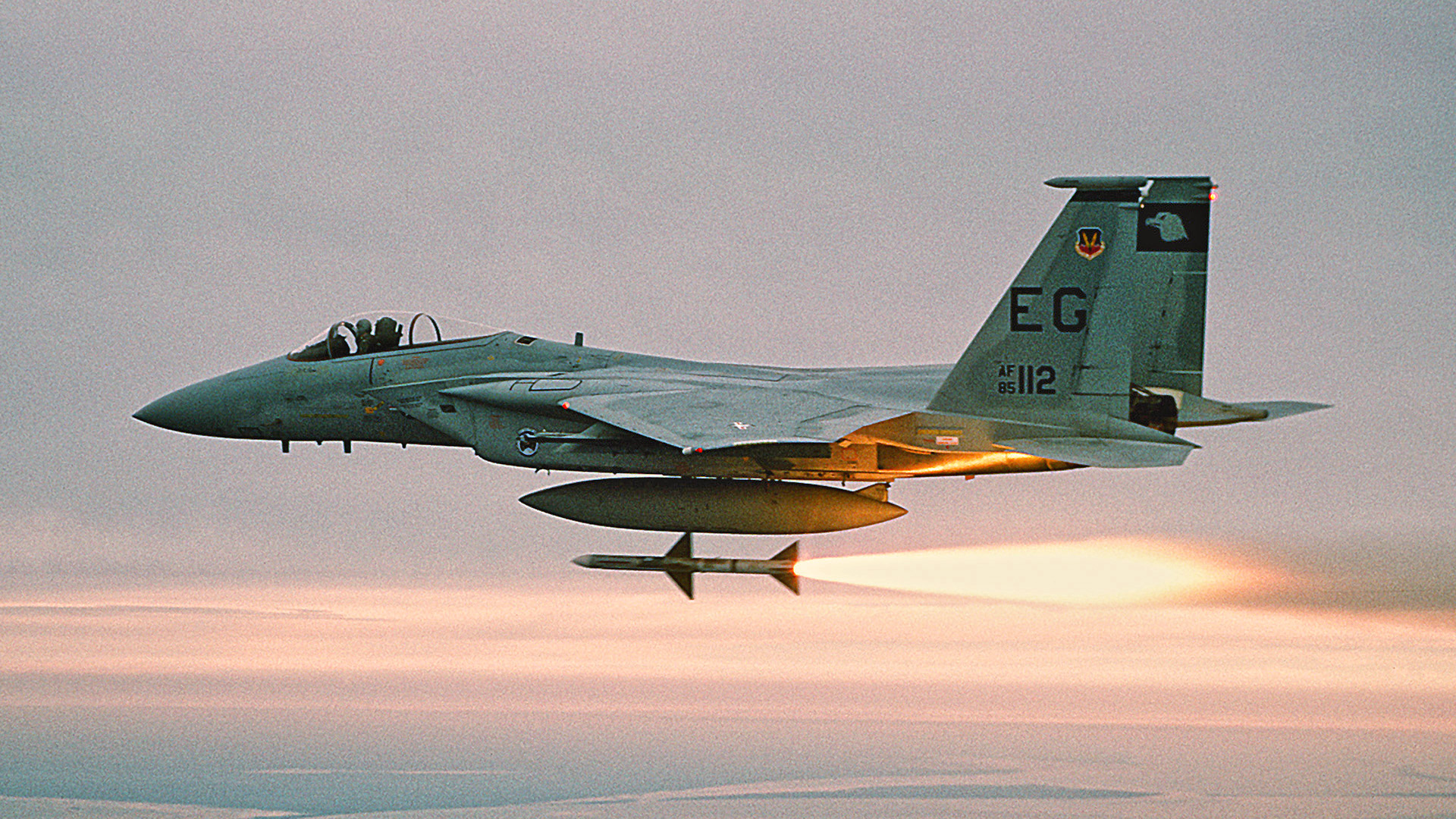
Contact the author: jamie@thedrive.com
